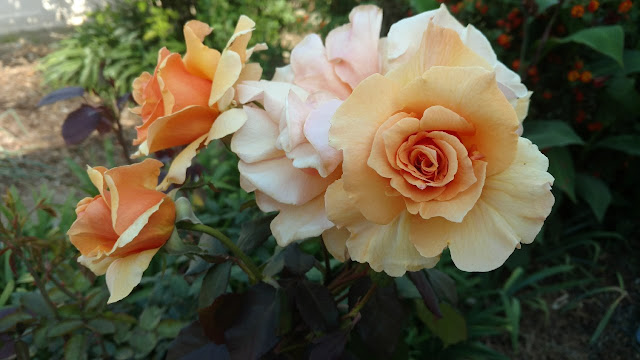More specifically, a cooling spray of water to wash away all that ash and dust on their leaves, preferably early in the morning so leaves will dry quickly. It not only refreshes the foliage, it can help fight spider mites.
Tiny as the period at the end of this sentence, spider mites are one of the few summer rose pests that can take August heat. They stipple (and eventually kill) leaves, sucking the life right out of them. Some species (but not all) leave telltale fine webbing on the underside of foliage. You need a magnifying lupe to actually see the mites.
According to University of California’s Integrated Pest Management research, spider mites love dry and dusty conditions. That’s why we often see outbreaks in the dead of summer. But these little pests can’t stand a good blast of cold water. A watering wand is ideal for this. It allows you to spray up and under the leaves, washing away mites and their webbing.
When mite populations explode, they also inhabit the top of leaves, so wash both sides. In addition, that summer cleaning can help the foliage better do its job, converting sunlight into food for the bush.
Spider mites really flare up when temperatures stay consistently above 80 degrees. Most insecticides and other chemical cures have little if any effect in controlling spider mites. Neem oil or insecticidal soap can put a dent in their numbers earlier in summer. But spraying anything besides water on bushes during this hot weather can cause more harm than good, burning foliage.
Spider mites have several natural enemies than can help keep them under control. Often, a mite infestation follows insecticide application that reduced the number of predators. So, stick to water.
Here are more tips on rose care in August:
Watch out for thrips.
The other major Sacramento rose pest of summer, Western flower thrips are minute insects that love to eat rose buds. They tunnel into petals, creating brown trails of destruction. You’ll see the damage before you see the bugs. Control by chemical means is almost impossible because the thrips do their dirty work inside the rose bud.
Thrips tend to attack light-colored, white or fragrant roses. They do the most damage in gardens where roses are tightly packed together. To keep thrips’ numbers in check, dead head spent flowers and dispose of them. The good news? Western flower thrips are a natural predator of spider mites.
Dead head for more blooms.
Remove spent flowers in August or bushes will start producing rose hips (their fruit) instead of fall bouquets. With sharp scissors or pruners, snip down to the first outward pointing five-leaf leaflet. The bush will produce another flush of flowers in six to eight weeks.
Water deeply.
Mature rose bushes need about five gallons a week in August, more if planted in containers. Bushes in the ground can be deep-watered once a week. In pots, they may need daily watering during triple-digit temperatures.
Mulch is your rose’s friend.
Organic mulch (shredded leaves, bark, etc.) maintains moisture, discourages weeds and keeps rose roots comfortable. Maintain mulch at about 3 inches deep, but don’t let it mound around the bush’s crown.
Thin competition.
If you grow companion plants around your roses, make sure they’re not strangling the bushes. Those companions are also competing for water.
Feed for fall flowers.
To encourage October blooms, fertilize in August. Pull back the mulch and sprinkle bone meal and worm castings around bushes, gently work those amendments into the soil, rake mulch back into place and deep water. Or feed with a half-strength liquid fertilizer after you’ve already deep watered the plants. (Roots need water in the soil to access those nutrients.)
Enjoy your roses.
They’ll bloom in this heat when other shrubs shrug and give up. Pick a bouquet to bring inside.
For more on rose pests:
http://ipm.ucanr.edu/PMG/PESTNOTES/pn7466.html
and
http://www.sactorose.org/rosebug/index.htm
Debbie Arrington is a consulting rosarian and longtime rose grower.

